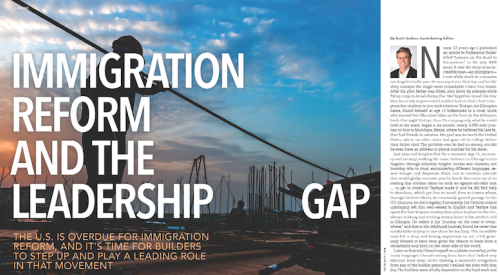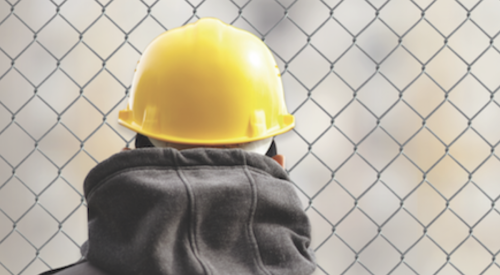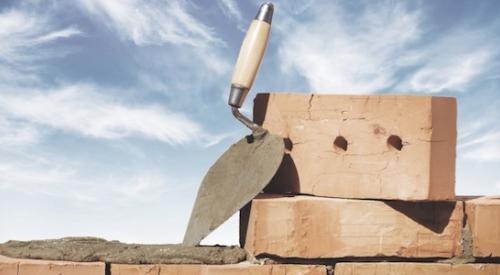|
No one knows exactly how much housing depends on illegal immigrant workers in the construction trades. Home builders are relying more every day on immigrant labor to fill the void left as a whole generation of experienced baby boomers retires from the subcontracting trade companies that actually put the industry together.
Some share of the immigrant workforce is illegal, with the highest concentration in Sun Belt states, where housing markets are strongest. If illegal immigrants are deported and if the flow of foreign construction workers into the U.S. is cut off, labor shortages will drive up costs. How much so is unkown.
Last spring, both houses of Congress passed immigration reform bills that authorize an attempt to close American borders to illegal immigration and enforce more punitive sanctions against employers who hire illegal workers. Unfortunately for those who want swift action, the two bills are vastly different in how they deal with illegal immigrants already in the country and the need for more immigrants to keep the economy humming.
An Industry DividedCongress is as divided as the country on what to do about illegal immigrants already working in the United States. Each party caucus has a chasm, and the housing industry also has a split personality. "NAHB adopted an official position on immigration a year ago, at the 2005 fall board of directors meeting," says Jenna Hamilton, NAHB's assistant staff vice president for legislative relations. "That policy says we support comprehensive immigration reform and a new visa system because the current one is obviously broken. There's a bias built into it favoring people with higher education and those with job skills valued by large corporations. It's slanted against people who work with their hands. The U.S. even calls them 'unskilled labor,' while builders call them 'skilled trades.' We have too few Americans capable of this work, much less willing to do it."
Hamilton says it's vital for housing to have immigration laws that reflect the reality of its urgent need for labor and a system that will allow people now working illegally to find a path to permanent legal residency.
Yet, she admits, many builders don't see it that way. "Every time we put out a policy statement, I get nasty calls and e-mails from members who don't agree with NAHB's position. It really breaks down like the split in the Republican Party. There's a wing of our membership that just doesn't want to see anyone rewarded for breaking the law."
But another wing of NAHB membership takes the attitude that housing really needs immigrants, Hamilton says. "They believe we should give them a chance to pass a background check and prove they are good people who deserve an opportunity."
Hamilton says one builder argued that if builders and their subs pay enough, they'll find Americans to fill construction trade crews. "I told him I don't know any subs who are paying minimum wage for framers and trim carpenters," she says, "and if you start paying $100,000 to roofers, who will be able to afford the house?"
However, many builders are so passionate about their politics that they are willing to sacrifice economic self-interest. But that may not last if it jeopardizes their ability to make a living. One of the problems is that no one knows exactly what percentage of housing's labor force is undocumented, so it's impossible to gauge how much it will raise costs if illegal immigrants are removed from the equation.
What We Do KnowThe Pew Hispanic Center in Washington is hailed as the authority on the illegal immigrant population. Senior research associate, Dr. Jeffrey S. Passel, published a report in March this year estimating the total illegal population at 11.5 million to 12 million.
The total was 11.1 million a year earlier. Some 7.2 million unauthorized were in the American labor force in March 2005.
About 19 percent of unauthorized workers in March 2005 were employed in what Passel calls "construction and extractive occupations."
NAHB's Natalia Siniavskaia published a paper on immigrant workers in construction trades in December 2005, analyzing the 2004 American Community Survey (ACS) from the U.S. Census Bureau. That data showed more than 15 percent of the total American workforce was born abroad. But the percentage for construction trades was even larger, around 20 percent. (ACS does not separate residential and non-residential construction.)
The study shows that 22 percent of carpenters and 32 percent of construction laborers were immigrants.
The percentage of immigrant construction labor that is undocumented is tough to figure, says NAHB economist Michael Carliner. "A key to what percentage is illegal is what share is from Mexico," he says, "because Mexicans are more likely to be illegal. I've seen data that suggests the flow of illegal immigrants peaked between 1999 and 2002 and has been somewhat lower since. But nobody knows for sure.
"The important point is, illegal immigrants working in construction are not just warm bodies," Carliner asserts. "They have significant skills that are in short supply in this country. What's surprising is how widespread dependence on immigrant labor is.
"Even in places like Chicago and Birmingham, Ala., we see immigrants dominating the job site. That's a long way from the Mexican border. The government should recognize we need people who can work with hand tools as well as computers."
As a builder, wherever your economic self-interest seems to fall on the Senate side of immigration reform, unless you like the idea of $100,000 a year roofers. Your votes in November might influence which way this goes.
|












